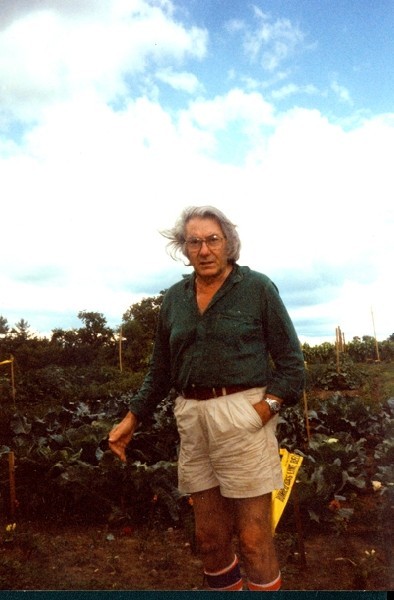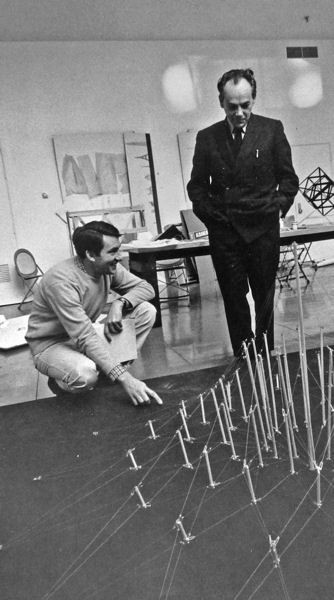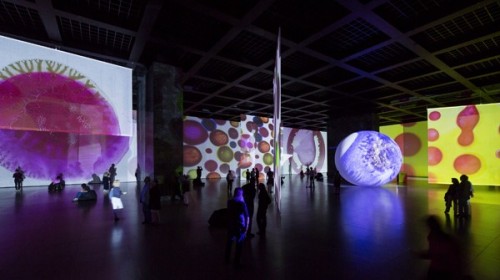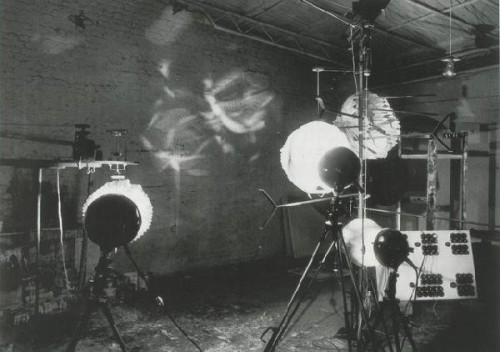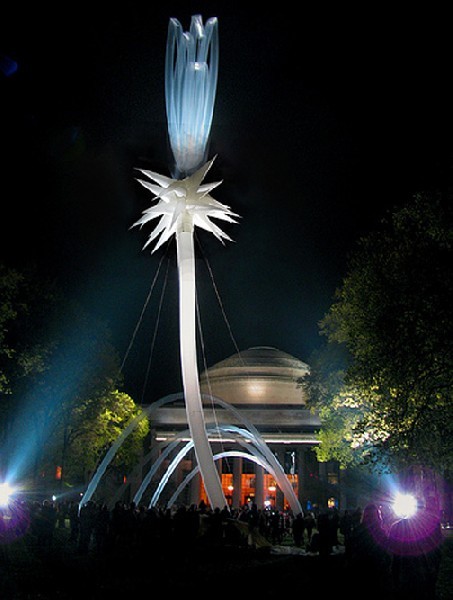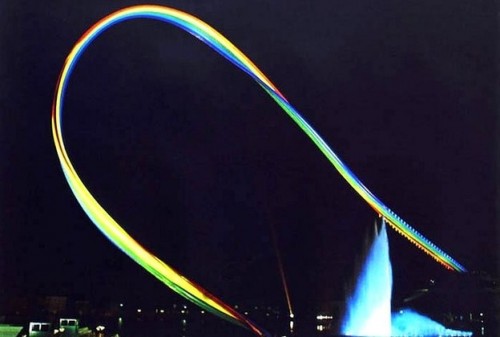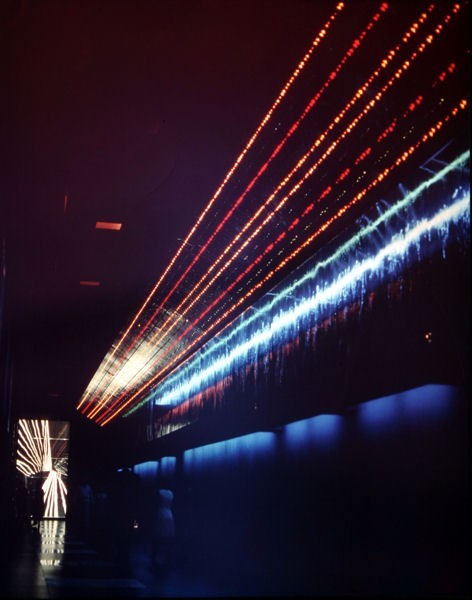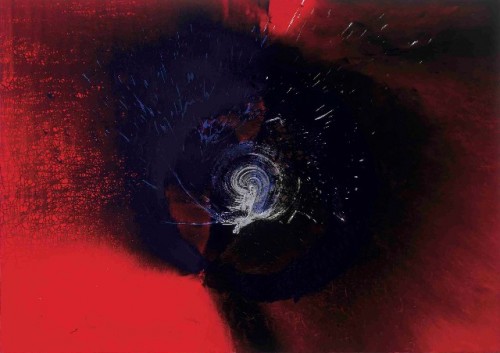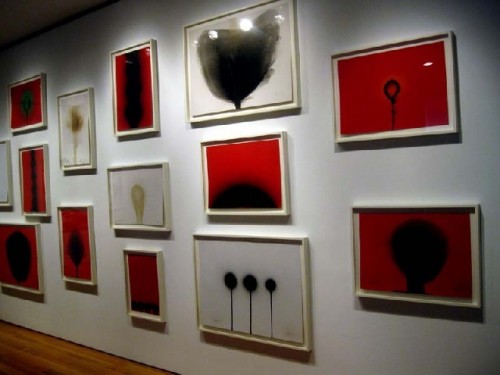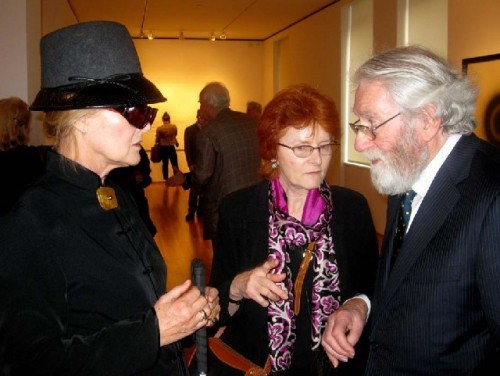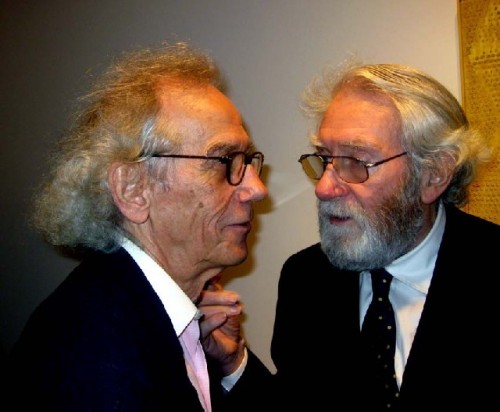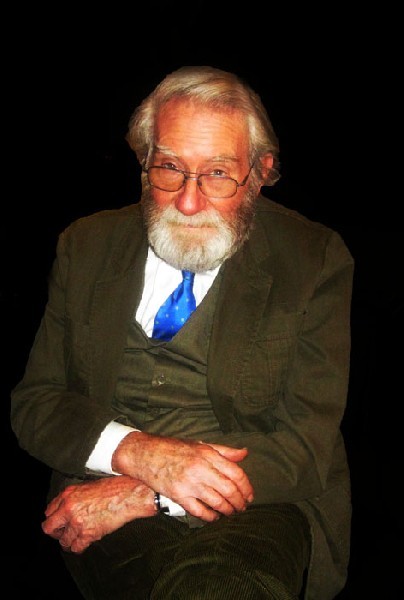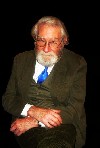Group ZERO Co Founder Otto Piene at 85
Guggenheim ZERO Exhibition to Open in October
By: Charles Giuliano - Jul 19, 2014
The energy, commitment and enthusiasm of the German born artist, Otto Piene (18 April 1928 – 17 July 2014), for making work, initating global projects and exhibitions was astonishing.
From a farm in Groton west of Boston he regularly commuted to a second home and studio in Dusseldorf.
This week he died at age 85 in a taxi in Berlin. He was there for his exhibition More Sky at the Neue Nationalgalerie museum. Following a successful opening, one of a number of European museum retrospectives in recent years, he was installing a Sky Art event, a field that he virtually invented, which was planned for this weekend.
The oeuvre of the artist was diverse including paintings created using fire to scorch pigmented surfaces, inflatable sky pieces, and kinetic light environments. He advised and collaborated with a wide spectrum of artists, scientists and engineers.
Piene was the first fellow of MIT's Center for Advanced Visual Studies (CAVS) and its Director from 1974 until his retirement in 1994. The Center which hosted fellows and granted masters degrees in the field of art/science/ technology was downscaled. He and his wife, Elizabeth Goldring, a CAVS fellow, co director and artist, continued to maintain office and studio space at MIT.
CAVS regularly hosted now renowned artists, and initiated hundreds of global projects. This included a collaboration of more than twenty artists and scientists for the 1977 Centerbeam for documenta 6 in Kassel Germany. After Kassel it was installed in the mall of Washington, D.C. There is discussion about recreating the seminal work in Germany.
Rarely was the work of Piene and CAVS seen in Boston. Conceptual artist Virginia Gunter curated the 1971 Museum of Fine Arts exhibition Air, Fire, Water: Elements of Art. The controversial, avant-garde project during the MFA’s centennial celebration occurred shortly before then director Perry T. Rathbone appointed Kenworth Moffett as the museum’s first curator of contemporary art. Since then the museum has not focused on art/science/technology.
For Elements Piene created "Charles River Rainbow" an inflatable sky art work which spanned the river between Boston and Cambridge.
His most famous such work was "Olympic Rainbow" consisting of five different-colored polythene tubes, each more than 1,500 feet long, which were inflated and released to close the 1972 Summer Olympics in Munich.
Under director Gabriella Jepson, in 1975, the ICA exhibited Boston Celebrations: Jubilee Projects by the Fellows of the Center for Advances Visual Studies, Massachusetts Institute of Technology. That was the ICA's last such initiative. There were unproductive talks about a DeCordova/ CAVS exhibition and a Sky Art exhibition and conference at Mass MoCA.
Other than New York's Howard Wise Gallery in the 1960s, until recently, Piene's generation of experimental art, with a few exceptions, was marginalized by the mainstream art world. The seminal role of Group ZERO inspiring kinetic, minimalist and conceptual art is only now surfacing. The Guggenheim exhibition will surely expand research and appreciation of this less known Post War movement.
Some eighteen years ago an artist alerted me to an evening of performances related to the closing of the CAVS building on Mass Avenue. The building with its famous "pit" was reassigned with the Center downscaled and moved to a floor that houses the MIT Museum.
In tribute to former Nam June Paik collaborator, Charlotte Moorman, the conceptual artist John Powell fabricated an ersatz cello. From the roof Piene and a crew launched the instrument above the Center. Previously Piene had lofted Charlotte who was known for nude cello concerts and for “playing” Paik.
Among the onlookers was Astrid Hiemer who had been Piene’s administrator at CAVS for a decade. We spoke that night and started dating soon after. Our lives merged including sharing associations with many CAVS fellows. After leaving MIT she was involved in special projects including translating and editing numerous individual essays in a major publication on Piene and his work. She also organized the archives of the Center which is a valuable resource in the field.
At the time I wrote an Art New England feature article on the changes for CAVS. I interviewed a number of fellows and MIT deans. This entailed a visit to Piene’s Groton home where I photographed him in shorts in front of a vegetable garden.
In the years since then we kept up with his exhibitions and projects including shows at New York’s Sperone Westwater Gallery which also organized exhibitions and publications related to Group Zero.
We look forward to ZERO: Countdown to Tomorrow: 1950s–60s, October 10, 2014–January 7, 2015 at New York's Guggenheim Museum. It is the first large-scale survey in the United States dedicated to the history of the German artist group ZERO (1957–1966) founded in 1957 by Heinz Mack and Otto Piene and joined in 1961 by Günther Uecker, as well as a larger network of like-minded artists from Europe, Japan, and North and South America—including Lucio Fontana, Yves Klein, Piero Manzoni, Yayoi Kusama, Jan Schoonhoven, and Jesús Rafael Soto—who shared the group’s aspiration to transform and redefine art in the aftermath of World War II.
As a teenager during the final days of the Third Reich Piene was both horrified and fascinated by the night sky illuminated by search lights, antiaircraft fire, bombs and flares. The images haunted him and he spoke of it in later years as a stimulus for the creation of sky art.
Evolving from the defeat and destruction of Germany the young ZERO artists sought a complete break from the romantic traditions and expressionism of Germanic art. Their experiments with industrial materials and technologies related to the Bauhaus movement (1919-1933) which was shut down after National Socialism came to power.
A difference was that Bauhaus conflated art and design. Its intention was to create products for industry and modernist architecture. ZERO artists were only interested in creating art with no pragmatic applications.
One of the major artists, László Moholy-Nagy, a Hungarian painter and photographer as well as professor in the Bauhaus emigrated to Chicago in 1937. He founded the New Bauhaus which closed after just one year. In 1939, Moholy-Nagy opened the School of Design. In 1944, this became the Institute of Design. In 1949 the Institute of Design became a part of Illinois Institute of Technology. It was the first institution in the United States to offer a PhD in design.
Accompanying him to Chicago was a Hungarian artist György Kepes (October 4, 1906 – December 29, 2001). In 1947, Kepes accepted an invitation from the School of Architecture and Planning at MIT to initiate a program there in visual design. That initiated the Center for Advanced Visual Studies in 1968. Piene became the Center’s first fellow in 1969. In 1974 he took over and expanded the program.
While director of exhibitions for Suffolk University/ New England School of Art and Design I showed Piene’s large, colorful, sky related works on paper. It was great to collaborate with him and through funding with the Goethe Institute we published a poster and organized related programming.
Since the 1971 Elements show at the MFA and the 1975 ICA show it was the first time that his work was exhibited in Boston. Many fellows attended the opening and we hosted a lively party at our then home in East Boston.
The exhibition was not reviewed by the Boston media.
That project helped me to appreciate Piene as an artist and humanist. There was such an enormous generosity of spirit. I don’t think he ever turned down an invitation to show or speak about his work. That ranged from our modest project to the most prestigious. He represented Germany at the Venice Biennale in 1967 and 1971, and exhibited at documenta in Kassel, Germany, in 1959, 1964, and with CAVS in 1977. Piene received the Sculpture Prize of the American Academy of Arts and Letters in 1996, and the Leonardo da Vinci World Award of Arts and UNESCO’s Joan Miró Medal in 2003.
His works are included in the collections of nearly 200 museums and public collections around the world including the Museum of Modern Art, New York; the Nationalgalerie Berlin; the Walker Art Center, Minneapolis; the National Museum of Modern Art, Tokyo; the Stedelijk Museum, Amsterdam; the Centre Georges Pompidou, Paris; and the MIT List Visual Arts Center.
Prior to when Kathy Halbreich founded the List Center for the Visual Arts she featured Piene and CAVS at the former Hayden Gallery. The List later showed little interest in the work generated on campus until now retired director Jane Farver. Her administration had a more intimate relationship with MIT and its remarkable accomplishments in the field of art/ science/ technology.
There was a sense of inclusion during Farver’s time at the List. She was welcoming to anyone who showed an interest in her insightful, cutting edge programming. She hired Bill Arning who made a point of visiting hundreds of studios and became the leading authority on emerging Boston artists.
After the reorganization of CAVS, under Otto and his successor scientist/holographer, Steve Benton, there was continued but decreased activity. We attended a number of performances and special events. Benton was followed by multi-media artist Krzysztof Wodiczko. There was further change under curator Uta Meta Bauer. She was the Founding Director of the Program in Art, Culture, and Technology at MIT's School of Architecture. In 2013 she left to become the founding director of the Center for Contemporary Art, Singapore at Nanyang Technological.
Piene's Sky Event at the MIT150 Festival of Art in 2011, in collaboration with Seth Riskin of the MIT Museum, students, and alumni, celebrated the creative spirit of CAVS. Also in 2011, the List Visual Arts Center under Farver exhibited Otto Piene: Lichtballet, highlighting the artist's exploration of light as an artistic and communicative medium.
In 2010 Piene was included in the DeCordova Biennial. One of his inflatable/ light works was shown in a small gallery with related graphic materials in an adjoining corridor. It was wonderful that he was given this long overdue local recognition.
Perhaps the MFA and ICA after a hiatus of four decades again will recognize Piene and the world class accomplishments of CAVS. It is embarrassing for the Boston art world that this is now happening at the Guggenheim and major international museums. In an e mail exchange a colleague suggested that this would be an appropriate project for Mass MoCA or Dia Beacon.
Being snubbed by the Boston art world, however, never seemed to bother Otto. He enjoyed living on the farm and commuting from it to the world. For Otto it was always about doing the work and the human contacts and collaborations that entailed. Significantly, he remained active, literally until the last moment of his life.
For those who loved, worked with, learned from, and respected him Otto’s impact on our lives was enormous. Through Otto, Astrid and I came to share a life in the arts. Truly he was an inspiration.
Links to related BFA articles.
Center for Advanced Visual Studies at MIT Celebrating a Remarkable Legacy by Zeren Earls
Sky Art 2011 At MIT Otto Piene Celebrates MIT's 150th by Mark Favermann
Honoring Otto Piene at Grand Palais, Paris Conference and Monograph Presentation by Astrid Hiemer
Monograph: Otto Piene by Ante GlibotaBook Launch at Duesseldorf City Hall by Astrid Hiemer
ACT Inauguration Celebration Program in Art, Culture and Technology at MIT by Zeren Earls
Otto Piene at Sperone Westwater Light Ballet and Fire Paintings, 1957-1967 by Charles Giuliano
New MIT Program ACT Inauguration CAVS and Visual Arts Program Merge by Astrid Hiemer
Group Zero at Sperone Westwater International Movement Surveyed in New York Exhibition by Charles Giuliano
Zero in New York Exhibition at Sperone Westwater Astrid Hiemer

